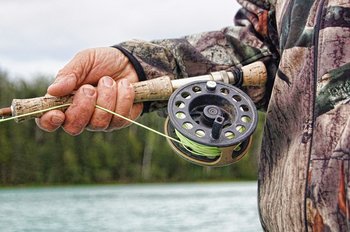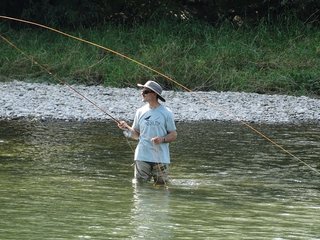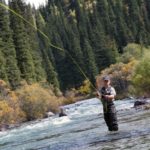Without the proper fly line, a fly rod is practically useless. But when it is paired with a line that has the right weight and taper, the rod and reel comes alive on the hand so casting feels almost effortless.
If you’re new to the sport of fly fishing, choosing the right fly line can be a very frustrating task especially if you get it wrong. Your casting may suffer, your fly may flop, and the fish may be spooked.
So, to help you with your fly fishing journey, this article introduces you to the basics of fly lines — how they’re constructed, the different styles available, the concept of tapers, and how to choose the proper line weight to match your rod.
Once you’ve digested these pieces of information, you’ll be able to decode the label of a fly line box and know with confidence if it’s the right fly line for you.
Conventional vs Fly Fishing
Casting a nearly weightless fly with a weighted line distinguishes fly fishing from all other forms of angling.
With conventional fishing tackle, the weight of the lure, bait, or sinker is used to cast a nearly weightless line. But in fly fishing, the exact opposite is true: the weight of the line is used to cast the fly. Think of a fly line as a “fly delivery system”.
Construction
Core
The core acts as the backbone of the fly line, providing the strength necessary to play and reel in a fish. Fly lines intended for all weather conditions typically have hollow, braided multifilament cores that remain flexible in warm or cold temperatures.
Those designed for use in warmer conditions often have stiffer braided monofilament core that reduces tangling for better casting performance.
Most fly lines for trout and bass fishing have core strengths of around 20-pound test. Saltwater fly lines and lines intended for larger fish species typically have core strengths of around 30-pound test, but can go as high as 60- or 80-pound test for big game fishing.
Coating
The coating gives a fly line its unique thicker-than-normal-fishing-line look and feel.
Modern fly lines are coated with synthetic materials like polyurethane, vinyl, and PVC that not only help the line slide through the rod guides, but also give the line its unique action in the water.
A fly line’s taper and weight are also determined by the specific coating used and how it’s applied.
Common Types
Floating Fly Lines
Floating fly lines are by far the most versatile and popular type. As their name implies, they float on or near the water’s surface. This floating action is a result of tiny air bubbles trapped within its coating.
Since they can be adapted for use in nearly any fishing situation and are typically the easiest type of fly line to cast, many fly anglers who fish in both freshwater and saltwater only use a floating line.
If you’re just starting out, a floating line is the way to go.
Sinking Fly Lines
While floating lines use air bubbles in their coating for buoyancy, sinking lines use heavy materials such as metals or minerals to cause the line to sink.
You’ll often hear sinking lines referred to as “full sinking lines” and they are available in a wide variety of sink rates given in inches per second (IPS).
Anglers use sinking lines when it is necessary to get a fly down deep in the water like when fishing lakes for trout, large rivers for salmon, or from jetties for striped bass.
Sink Tip Fly Lines
This hybridized type of fly line is essentially a floating line with a 20- to 30-foot length of sinking line at the front.
With a sink tip line, the majority of the line remains floating on the surface while only the tip sinks. This action can help you stay clear of snags at the bottom structure of a river.
It is favored by anglers who fish subsurface flies like nymphs and streamers.
Understanding the Fly Line’s Taper
Though often a source of major confusion and heated debate, the taper of a fly line simply describes the shape or gauge of the line from end to end.
The main purpose of a taper is to increase the efficiency of the fly cast. The most basic fly line taper is thin at the back end of the line and thicker at the front end, gradually increasing in thickness until the front end of the line is heavier than the back end.
With the weight distributed in this manner, the increased weight at the front end of the line helps bend and load the rod with energy, which can then be transferred back to the line through the casting stroke in order to launch the line through the air.
The fly line taper you choose should be primarily based on the fishing techniques you intend to perform, and the water and wind conditions with which you must cope.
Certain tapers work better for casting dry flies. Some make it easier to perform specific fly casts, and others make it possible to cast head-on into the wind.
Here are three of the most common fly line tapers explained.
Weight Forward
Fly lines with a weight forward taper are the most popular and easiest to cast. You’ll find almost every type of fly line — floating, sinking, intermediate, and sink tip — available in a weight forward taper.
With this type, most of the line’s weight is positioned in the front 20 or 30 feet of the line. This front-heavy design allows for very efficient casting, using the weight in the head to carry the rest of the line forward — similar to how a weighted lure on a spinning rod carries the line when cast.
Weight forward lines can be used for various fishing scenarios and are especially beneficial for new fly anglers learning how to cast. If you’re not sure which taper to choose, a weight forward line is a great place to start.
Double Taper
A double taper line has weight both in the front portion and the back portion of the line, with each end tapering towards a slimmer middle. The result is a line with more overall mass throughout its entire length than a weight forward line.
This is beneficial when performing certain fly casts and maneuvers such as the roll cast and the upstream mend.
Shooting Head
A shooting head taper is like a condensed version of a weight forward taper.
Instead of going from thin to thick in a gradual way, shooting head lines have a much more aggressive taper with the front 10 to 15 feet of line being very thick and heavy while the rest of the line is relatively thin.
You should consider using a shooting head line if you regularly fish in conditions with strong winds, as the heavier head section helps the line penetrate the wind.
Shooting head lines can be very helpful when you need to make extremely long, accurate casts, as when saltwater flats fishing.
Importance of the Correct Weight
For a fly rod to successfully cast a fly line, the line must have enough mass to flex the rod sufficiently during the casting stroke. If the line is not heavy enough, the rod won’t flex and there won’t be enough stored energy to make a successful cast.
If the line is too heavy, it can bend the rod too much which in turn slows down the rod’s rebound, resulting in slower line speed and less casting distance.
All fly rods are designed for a specific line weight. The good news is, it’s usually printed on the rod blank near the handle. Simply purchase a fly line that matches the weight on the fly rod and you’re good to go.
Check our article on how to cast a fly rod to learn more about what goes into successful casts.
Line Size
You’ll find fly lines ranging in sizes, from 0 all the up to 16. Line sizes 3 through 7 are the most common for freshwater fishing, while sizes 8 through 12 are most common for saltwater fishing.
Unlike conventional fishing rods and reels that allow you to use different line strengths on the same outfits, fly rods are line weight specific. While you can use a 5-weight line on a 4-weight rod, it won’t perform as well as the proper match.
For this reason, it’s crucial that you take the time to assess your needs before buying your rod so you have the right rod and line to handle the fish you’re after.
Essential Factors to Ponder on
Fly fishing is a very personalized sport. Every piece of gear you buy should be determined entirely by your fishing style, the water you fish on, and the species you chase. This is especially true when selecting a fly line.
Before you decide on which fly line to buy, use the information provided in this article to help you figure out what style of fly line will suit you best — floating, sinking, or sink tip.
Then, consider whether a standard weight forward line will suffice or if you need something more specialized like a double taper or a shooting head. Look at the markings on your rod blank to know the line size you need.
For sure, you’ll be casting and fishing a well-balanced rod, reel, and line in no time. But before you get to that, you’re also going to need to know a thing or two about fly leaders and the essential knots you need to know to connect the line to the leader to the fly.
















